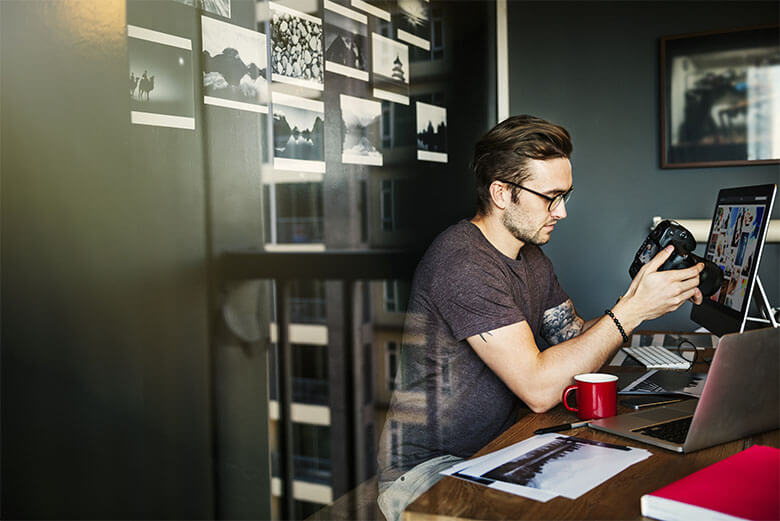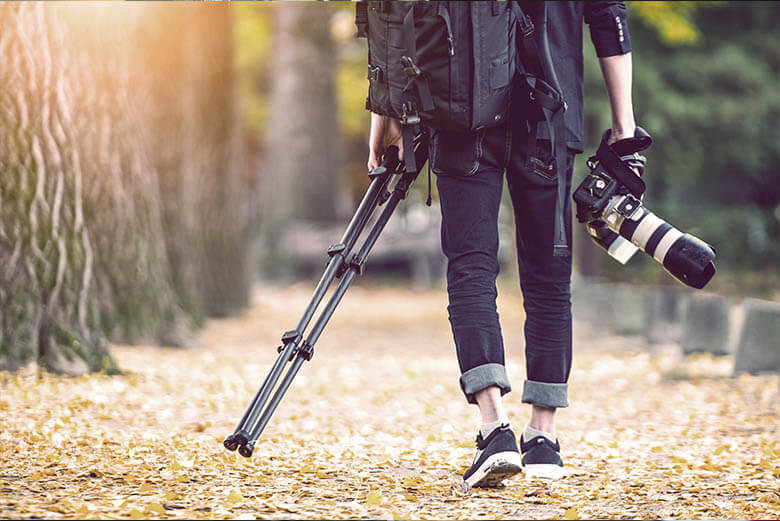
Freelance photographer: The path to independence
For many passionate photographers it is a long-cherished dream to turn their hobby into their profession. Those who are always looking for new creative challenges in everyday life will sooner or later ask themselves whether this artistic activity can also be combined with professional life. In this article we inform you about the possible ways in which you can take up a secondary occupation or a self-employed activity as a photographer and explain to you the basic requirements for becoming a freelance photographer.
Possible career paths as a photographer
There are several ways to work professionally as a photographer. The classic training path is a technical apprenticeship as a “photographer”, which is completed theoretically at a vocational school and practically in a photo studio. However, it is still possible to follow the career path of the photographer through a lateral entry or intensive self-study. Sound artistic and creative knowledge from other education, study programmes or private interests with sufficient practical experience make such a career path possible.

Career start in side business
If you want to establish yourself in a new professional field, it is advisable to start this venture alongside an existing employment relationship. With a permanent position, it is even possible for you to found a (single) company as a sideline. Setting up your own business can sometimes involve some financial risks: Owners of a sole proprietorship are liable with their private assets. If you remain employed for the time being, you have additional security during the potentially difficult start-up phase. You have a secure job that you can fall back on if necessary. The income from your existing employment covers your living expenses. In the event of bankruptcy, this “safety net” reduces the risk of going into private bankruptcy.
If you intend to work as a photographer on a part-time basis, you naturally need the consent and acceptance of your employer: Your activity must not violate any stipulations in your employment contract. In addition, your new company must not be in competition with your current company. In Switzerland, this is laid down in Art. 321a of the Swiss Code of Obligations:
„During the term of the employment relationship, the employee may not perform any work for remuneration for a third party if the employee thereby violates his/her duty of loyalty, in particular by competing with the employer.“
Accordingly, you may not conduct independent business with customers of your employer. In such cases, there is otherwise a risk of termination without notice. If you want to continue working full-time, you must also expect an increased workload. With the consent of your employer, you can, of course, move from full-time to part-time employment and thus have more time and energy for your part-time work as a photographer.
If you want to set up a sole proprietorship in Switzerland, please note the following information:
- Obtain the necessary permits in advance, clarify the recognition of self-employment with the AHV-administration class, check the necessary insurance.
- Specify a location and a name for your company – for sole proprietorships your surname must be included in the company name.
- Register with SVA Zurich for your social security contributions.
- Companies with an annual turnover of CHF 100,000 or more are subject to value-added tax.
- An entry in the commercial register is mandatory for annual sales of CHF 100,000 or more.
Important: Social security contributions are only payable from an annual income of CHF 2,300. If the wage total is still below this amount, social security contributions are voluntary. When filing your tax return, however, you must always state the full amount of income from a secondary activity, otherwise there is a risk of severe penalties. However, you can also claim deductions for professional expenses for sideline work.

Self-employment for photographers
Whether you choose to start your career in a secondary occupation or concentrate entirely on self-employment from the outset, the path to becoming a freelance photographer is not always straightforward. For a successful, independent activity as a photographer you need trained photography knowledge. You can acquire this knowledge through self-study or further training, but what counts most is practical experience. Here we have collected some concrete tips for prospective freelance photographers:
1. Train and perfect your photographic skills
As a freelance photographer, you need to stay in practice and improve and maintain your skills. Even if you don’t have a job at the moment, you should work on creative projects. This way you will constantly improve your skills and build up a portfolio. With this portfolio you can present yourself at agencies, but also on your own website and thus become more tangible for future customers.
2. Make contacts in the photography business.
Establish and maintain contacts. On the one hand you should place your portfolio with an agency, but on the other hand you should not neglect networking. Maintain relationships with other creative minds, such as graphic designers and designers – in the best case, you can establish contacts with each other’s customers and thus create valuable orders.
3. Nutzen Sie die sozialen Netzwerke.
In addition to traditional networking, you can also use social media to establish yourself as a photographer. For example, many freelance photographers maintain a blog or publish part of their art on platforms such as Instagram. Present camera equipment, give photo tips or share your most impressive shots: Contact with an interested photo community can help increase your profile and get to know potential customers. At best, you can even use blogging as a second pillar.
4. Position yourself as a photographer.
If you want to work as a contract photographer, you should concentrate on a part of the photography, for example portrait, architecture, fashion, landscape, or advertising photography. By focusing on a specific area, you have a better chance of positioning yourself as an expert. Agencies as well as private clients more often place their trust in specialised photographers, giving you a competitive advantage.
5. Save costs when starting your career.
As a freelance photographer you need professional equipment and, if necessary, your own photo studio to carry out orders. Especially when starting your career, however, it is advisable to build up and accumulate this equipment slowly instead of investing large sums of money from the outset. Studio rooms can also be rented as needed or, under certain circumstances, can be set up within your own four walls in order to keep costs down at first.
6. Join an association.
If you want to work full-time and independently as a photographer, membership in an organisation or association of photographers is also advisable. These usually offer legal advice, further training, an online presentation of their members, insurance solutions at special conditions, and guidelines for calculating expense allowances and fees. The associations make different demands on potential members – admission requirements are usually a portfolio review or proof of a certain professional experience. Currently active professional associations for photographers in Switzerland:
Conclusion
There are especially many autodidacts in artistic professions – and this knowledge and talent can certainly be transformed into a successful career. If you intend to follow this “side entry” path, you must decide in advance whether you want to work as a part-time or full-time photographer. In many cases, a part-time job can sooner or later be converted into a full-time self-employment. As a sole proprietor, you also have the option of converting your company form into a GmbH or AG – then you no longer have to be liable with your private assets.
